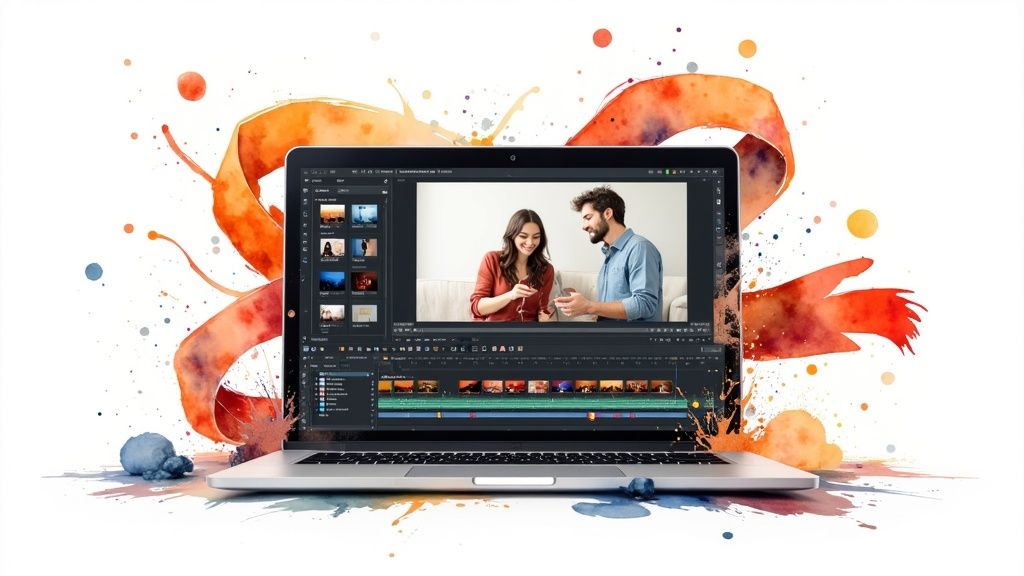Master video production project management with proven strategies. Learn how production managers streamline workflows and deliver exceptional content.
In This Article
Subscribe to our newsletter
The Evolution of Modern Video Production Management

The way we manage video production has changed dramatically in the past few years. Teams are moving away from traditional methods that relied heavily on in-person meetings and physical equipment. This shift comes from advances in technology, new client needs, and growing demand for quality video content across multiple platforms.
The Impact of Digital Technologies
Digital tools have reshaped every part of making videos - from planning shots to editing final cuts. Teams now collaborate through cloud-based platforms that let them work together no matter where they are. The COVID-19 pandemic sped up this change in a big way. Before 2020, most TV and film productions happened on location with everyone present. But when travel restrictions and social distancing became necessary, production teams quickly adapted to remote work. This meant using online tools to keep creating content without meeting in person. The result? Teams discovered they could work more flexibly and efficiently while partnering with talent worldwide.
Making Video Production More Flexible
More video teams are now using agile methods to manage their projects. Instead of following rigid step-by-step plans, they break work into smaller chunks that they can adjust as needed. This helps them respond better when clients want changes or when new ideas come up during production. Teams can get feedback more often and make improvements along the way.
New Ways of Working Together
As production methods change, so do people's roles on video teams. The clear lines between different jobs are starting to blur. Now, team members often handle multiple responsibilities and work more closely together. For example, editors might join early planning meetings to share what's possible with different shooting styles. This teamwork leads to smoother productions where everyone understands the shared goals. Looking ahead, success in video production will depend on being able to adapt quickly while delivering excellent results.
Mastering Cloud-Based Production Workflows
Cloud platforms are reshaping how teams handle video production from start to finish. These tools make it simple to coordinate every phase - from initial planning through editing and distribution. The result? Teams can work more freely, share ideas instantly, and get more done in less time.
Streamlining Collaboration and Asset Management
Having all project materials in one central cloud location changes everything. Scripts, storyboards, footage, edits, and feedback live together in perfect harmony. Gone are the days of hunting through endless email chains - now team members can find exactly what they need, when they need it. Picture an editor grabbing the latest script revision while a producer reviews client comments in real-time. Plus, robust version tracking ensures everyone works from the right files.
Tools like LucidLink have made cloud-based media storage a game-changer for production teams. With files synced in real-time across locations, the back-and-forth of email attachments becomes ancient history. Teams stay perfectly coordinated even when working remotely. Projects flow smoothly from one phase to the next without location getting in the way.
Optimizing Workflows Across Time Zones
Cloud tools shine when it comes to global collaboration. Since everything lives online - from project files to team chats - geography stops being an obstacle. This proves invaluable for productions spanning multiple time zones or tapping into remote talent. For example, a director in Los Angeles can seamlessly collaborate with an editor in London and a client in Tokyo, accessing the same files and communicating clearly throughout. Learn more about maximizing these tools in our guide on AI in advertising.
Balancing Automation with Creative Control
While cloud platforms automate many routine tasks, they put creative teams firmly in the driver's seat. Custom workflow settings and granular permissions let production managers shape the system to their exact needs. This means tedious work like file uploads and approvals can be automated without limiting creative freedom. The sweet spot lies in using automation to handle the mundane while preserving full creative control where it matters most. This thoughtful blend of efficiency and artistry forms the foundation of successful video production management.
Strategic Team Building and Resource Optimization

The success of any video production depends heavily on having the right team in place. Good project management isn't just about finding talented individuals - it's about creating a group that works together smoothly and effectively. This takes careful consideration of how different roles and personalities mesh together.
Identifying and Selecting Talent
When building a video production team, looking beyond technical abilities is essential. While having strong skills is important, qualities like communication, adaptability, and teamwork are equally valuable. For instance, an editor might be technically skilled but struggle to incorporate feedback or work collaboratively. The best candidates demonstrate both professional expertise and strong interpersonal abilities.
Optimizing Skill Distribution and Team Dynamics
After assembling your team, matching people to the right roles becomes crucial. This means assigning tasks that play to each person's strengths and interests. Regular team meetings, clear communication channels, and opportunities for collaboration help build strong working relationships. When team members understand their roles and feel supported, the quality of work naturally improves.
Resource Allocation for Optimal Efficiency
Smart resource management is key to keeping video projects on track and within budget. This includes coordinating personnel, equipment, and funding across all production phases. A typical project might need 10 scriptwriters, 5 videographers, and 3 editors working on different aspects simultaneously. Learn more about effective resource planning in video production here. Good planning helps prevent bottlenecks - for example, scheduling extra editing time or staff for complex post-production work.
Managing Creative Personalities and Fostering Collaboration
Creative professionals often have unique working styles and preferences. The key is finding ways to support individual creativity while keeping everyone aligned with project goals. This might mean setting up brainstorming sessions, using project management tools, or creating mentorship opportunities. When teams feel both creatively fulfilled and professionally supported, they produce better work and enjoy the process more. Building this kind of positive team culture takes time and attention, but the results show in the quality of the final product.
Pre-Production Excellence: Planning for Success

Success in video production starts with focused planning during pre-production. This early stage helps teams identify and solve problems before they affect the timeline or budget. By setting clear expectations and processes upfront, production managers can turn what could be a chaotic project into a smooth operation.
Building a Clear Planning Framework
The best production managers know that detailed planning prevents major issues down the line. They start by getting everyone aligned on the project's core goals and scope. A strong project brief needs to spell out who the target audience is, what key messages need to come across, and what specific outcomes the team wants to achieve.
Key Pre-Production Tasks and Steps
Several critical tasks require coordination during pre-production. Budget planning means carefully allocating resources across every stage of production. Location scouting involves finding and securing filming spots early, considering factors like lighting quality, ease of access, and required permits. The team also needs to handle talent coordination - from casting to scheduling and making sure cast and crew have what they need.
Managing People, Time, and Risks
Keeping everyone in the loop is essential for pre-production success. This means regular updates to clients, sponsors, and other key players about how the project is progressing. The team needs realistic schedules that account for every step from writing scripts to filming and editing. Having a solid risk management approach helps head off potential problems - like keeping backup equipment ready, having alternative filming locations lined up, or planning what to do if delays happen. For more tips on creating successful video content, check out our guide on Social Media Video Best Practices.
Staying Flexible While Planning
While thorough planning matters, the ability to adapt when needed is just as important. Issues can pop up unexpectedly, so building in some flexibility helps teams adjust without losing sight of their core goals. This means viewing pre-production as a living process that can shift based on changing needs while still maintaining clear direction and accountability.
Quality Control Systems That Actually Work
Creating amazing videos requires more than quick spot checks at the end. A well-designed quality control system ensures excellence at every step - from initial concept through final delivery.
Establishing a Multi-Tiered Review Process
Think of quality control like pouring water through progressively finer filters. Each stage catches different issues before they become major problems. This begins with a thorough script review to ensure the message is clear and accurate. Next comes the storyboard review where the team checks if visuals match the script's intent. The rough cut review provides early feedback on pacing and flow, while the final cut review zeros in on technical elements like audio quality and color grading. This layered approach means every aspect gets proper attention.
Feedback Collection and Implementation
Getting and using feedback effectively is key to quality control success. Set up a clear process for gathering input from everyone involved - clients, producers, and creative team members. Simple tools like shared online documents help organize feedback in one place. For instance, use a spreadsheet to track revision requests, who's handling them, and completion status. Having standard guidelines for giving constructive feedback helps avoid confusion and keeps the project moving forward.
Version Control and Approval Workflows
Keeping track of file versions is essential in video production. Without proper version control, teams waste time working on outdated files or making redundant changes. Cloud storage systems that automatically track version history are incredibly helpful here. Equally important is having a formal approval process with designated reviewers and clear deadlines at each stage. This prevents costly mistakes and keeps projects on schedule.
Balancing Creative Excellence with Technical Precision
Great video production managers know how to encourage creativity while maintaining technical standards. While giving creative teams room to experiment and innovate is important, they also need clear technical requirements for things like video resolution, frame rates, and sound quality. The goal is creating an environment where creativity can flourish within defined technical boundaries. Learn more in our article about Understanding the Importance of Quality Content. When you get this balance right, the result is videos that are both technically sound and creatively compelling - exactly what clients expect.
Measuring Success: Beyond Basic Metrics

Creating great videos requires more than just technical skill and creativity - it demands a clear understanding of what makes a project successful. View counts and likes only tell part of the story. To truly gauge effectiveness, you need to look at how your videos support bigger business goals and resonate with your target audience.
Defining Key Performance Indicators (KPIs)
Your video's purpose should guide which metrics matter most. For brand awareness campaigns, focus on metrics like reach, impressions, and social shares. If you're driving sales, pay attention to conversion rates, click-through rates, and website traffic from video content. Setting these specific KPIs upfront helps align everyone's expectations and provides clear success benchmarks.
Tracking Team Performance and Demonstrating Value
Closely monitoring how your team executes projects reveals valuable insights. Track key factors like meeting deadlines, staying within budget, and overall productivity. This data helps identify strengths to build on and areas needing improvement. When presenting results to stakeholders, focus on connecting video performance to concrete business outcomes through data-driven reports.
Data Collection and Analysis for Continuous Improvement
Regular data analysis throughout the production process highlights opportunities to work smarter. For example, viewer engagement patterns can shape future content decisions to better connect with your audience. Testing different approaches and measuring results creates a feedback loop that steadily improves your video strategy over time.
Utilizing Qualitative and Quantitative Measures
The most complete picture comes from combining hard numbers with audience feedback. While metrics like views and conversions matter, don't ignore what viewers are saying in comments, surveys, and focus groups. A video might get lots of views but receive negative feedback - a sign that the content missed the mark. Looking at both types of data leads to more informed decisions.
A successful video strategy needs clear goals, consistent measurement, and ongoing analysis. By tracking the right KPIs, gathering audience feedback, and using data to improve, you can create videos that genuinely impact your business. Looking to streamline your video production workflow? Check out Aeon, a powerful platform designed to help teams create better videos more efficiently.

.jpg)